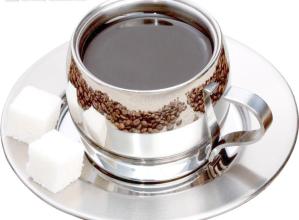Production method and nutritional composition of coffee beans
Production method
Coffee beans
Coffee beans
After harvest, peel, pulp, racing peel and silver peel should be removed before shipping and listing. There are two kinds of methods: drying (also known as natural or non-washing) and washing.
Dry type
The method is relatively simple. First of all, spread the freshly harvested fruit on the sun field for a week or two until the fruit crackles and dries naturally. After that, the dried pulp, endocarp and silver peel are removed by a sheller.
Coffee beans refined in this way are slightly sour and slightly bitter. Almost all coffee beans produced in Brazil, Ethiopia, Yemen and other places are obtained in this way. The disadvantage of this method is that it is easily affected by the weather and is easy to be mixed with defective beans and other impurities. Therefore, it must be carefully screened.
Washing type
The fruit that is about to be harvested is put into a flowing trough. After the floating fruit is removed, the skin and flesh are removed by a pulp remover. Then put it in the sink to remove the emerging pulp. After that, move into the fermentation tank, soak for half a day to a day, and then dissolve the gum on the surface of the fermented coffee beans.
After washing with water, drying it for a few days, drying it with a machine, and finally using a sheller to remove the endocarp to become a commercial raw coffee bean. In this way, it will be more beautiful in color and less impurity than dried coffee beans. Colombia, Mexico, Guatemala and other countries use this method for about 70% of their production.
Mode comparison
The coffee beans are treated after harvest, otherwise they will begin to ferment, making the coffee beans smell bad. The main treatment methods are "drying" and "washing", these two methods will cause different flavors. Dry beans have complete natural mellow taste, gentle aroma and more gum, while water washing has good mellow taste, high aroma and lively sour taste, which is also the source of sweetness in espresso.
Nutritional composition editing
Caffeine
Caffeine is the most eye-catching of all the ingredients of coffee. It is a kind of phytoflavin (animal muscle ingredient). Its properties are the same as theobromine in cocoa, green tea contains the same theophylline, and the percentage of reduction after baking is very small. Caffeine has a wide range of effects. It can accelerate the metabolism of the human body and keep people clear-headed and sensitive. The refreshing effect of coffee is very popular. Some people will lose sleep after drinking coffee at night, while others will be nervous and overexcited if they drink too much coffee, but many people will not be affected at all. Once we understand the body's response to caffeine, we can use it to meet our needs. Drinking a cup of delicious coffee before the exam or long-distance driving will certainly reduce fatigue.
Tannic acid
After extraction, tannic acid will turn into a yellowish powder, which can easily blend into water, and after boiling, it will decompose and produce pyrosylic acid, which will make the coffee taste worse, and if it is brewed and left for several hours, the color of the coffee will become thicker than when it was just brewed, and it is also less tasty, so there is the saying that "it is best to drink it as soon as possible."
Fat
The fat contained in coffee plays a very important role in flavor. After analysis, it is found that there are many kinds of fat in coffee, the most important of which are acidic fat and volatile fat. Acidic fat means that the acidic strength of fat varies with different types of coffee, and volatile fat is the main source of coffee aroma. Once the fat in roasted coffee beans comes into contact with the air, it will change chemically and the taste will get worse.
Protein
The main source of calorie is protein, and like dripping coffee, most of the protein will not dissolve, so no matter how much coffee you drink, the nutrition you get is limited, which is why coffee will become a sacred food for dieters.
Sugar
Without sugar, you will not only feel the bitterness of caffeine and the sour taste of tannin, but also feel sweet, which is caused by the sugar contained in the coffee itself. After baking, most of the sugar will be converted to caramel, bringing a unique brown to the coffee.
Mineral substance
There are lime, iron, sulfur, sodium carbonate, phosphorus, chlorine, silicon and so on, because the proportion of very little affect the flavor of coffee is not big, combined to bring only a little astringent taste. Crude fiber: raw bean fiber will be carbonized after baking, this carbon and sugar caramelization combine with each other to form the tone of coffee, but the fiber turned into powder will have a considerable impact on the flavor of coffee. Therefore, we do not encourage the purchase of powdered coffee beans because we are less able to taste the flavor of the coffee.

Important Notice :
前街咖啡 FrontStreet Coffee has moved to new addredd:
FrontStreet Coffee Address: 315,Donghua East Road,GuangZhou
Tel:020 38364473
- Prev

Introduction to the origin of Costa Rican coffee
Costa Rican coffee has full particles, ideal acidity and unique strong flavor. Costa Rica's coffee industry, originally controlled by the Costa Rican Coffee Industry Company (InstitutodelCafdeCostaRica, ICAFE), has been taken over by the official Coffee Committee (OficinadelCaf). In the coffee exported, those products that are considered to be of substandard quality use blue.
- Next

Bad types and grade planning of coffee beans
Bad kinds of coffee beans fermented by falling into the soil before harvest. The moldy smell will have a great impact on the taste of coffee. Dead beans, also known as unripe beans, or affected by climatic factors, the development is not perfect. Fried spots will be produced after baking, making the coffee have a green and astringent taste. Black beans fermented beans, coffee beans that have rotted and blackened. Because it is black, it can be used with normal coffee at a glance.
Related
- Detailed explanation of Jadeite planting Land in Panamanian Jadeite Manor introduction to the grading system of Jadeite competitive bidding, Red bid, Green bid and Rose Summer
- Story of Coffee planting in Brenka region of Costa Rica Stonehenge Manor anaerobic heavy honey treatment of flavor mouth
- What's on the barrel of Blue Mountain Coffee beans?
- Can American coffee also pull flowers? How to use hot American style to pull out a good-looking pattern?
- Can you make a cold extract with coffee beans? What is the right proportion for cold-extracted coffee formula?
- Indonesian PWN Gold Mandrine Coffee Origin Features Flavor How to Chong? Mandolin coffee is American.
- A brief introduction to the flavor characteristics of Brazilian yellow bourbon coffee beans
- What is the effect of different water quality on the flavor of cold-extracted coffee? What kind of water is best for brewing coffee?
- Why do you think of Rose Summer whenever you mention Panamanian coffee?
- Introduction to the characteristics of authentic blue mountain coffee bean producing areas? What is the CIB Coffee Authority in Jamaica?

